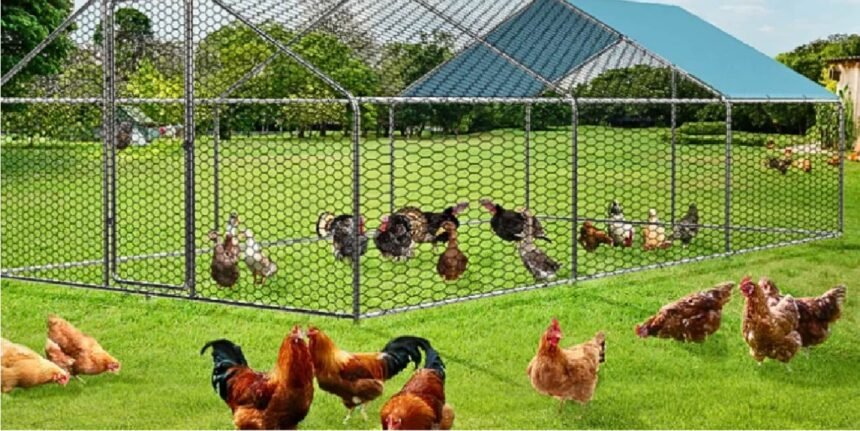Raising chickens on a farm can be a rewarding experience. Whether you’re raising them for eggs, meat, or simply for their charming presence, creating a safe and comfortable shelter for your flock is crucial. Chickens need a place to rest, roost, and lay their eggs, all while being protected from predators. In this guide, we’ll walk you through the essential steps to build a secure and cozy chicken coop that will keep your birds happy and healthy.
1. Choosing the Right Location
Before you start building, the first step is choosing the right location for your chicken coop. The site you select will determine how comfortable and secure your chickens feel. There are a few things to consider when picking the best spot.
Accessibility and Convenience
Your chicken coop should be easily accessible to you for daily care, such as feeding, egg collection, and cleaning. If you plan on having multiple coops or a larger farm, make sure there’s enough space to move around easily. Proximity to your home is also important, so you can monitor your flock without having to trek too far out.
Sunlight and Ventilation
Chickens need natural light to help regulate their laying cycles. Choose a spot that gets plenty of sunlight during the day, but not direct sunlight all day long—this could lead to overheating during hot months. Also, ensure that the location allows for good airflow. Proper ventilation is crucial to prevent the buildup of ammonia from chicken waste, which could be harmful to their health.
Drainage and Ground Conditions
Avoid placing the coop in areas that flood easily. Proper drainage will prevent water from accumulating inside the coop, which could lead to soggy bedding and health issues. Ensure the ground is firm and dry, particularly during the winter months.
2. Designing the Chicken Coop
Once you have the location figured out, it’s time to design the coop itself. A good design will keep the chickens comfortable while being easy to clean and maintain. There are several factors to think about.
Size and Space Requirements
The size of your chicken coop will depend on how many chickens you have. A general rule of thumb is to allow at least 2 to 3 square feet per chicken inside the coop. This ensures they have enough room to move around, roost, and lay eggs. However, chickens also need a run or an outdoor area to explore. A run should provide at least 8 to 10 square feet per bird.
If you plan to raise a large flock, consider incorporating multiple levels inside the coop to maximize space. This will allow your chickens to spread out and roost comfortably.
Nesting Boxes and Roosting Bars
Chickens need a place to lay their eggs in privacy and comfort. A nesting box provides just that. A general guideline is to have one box for every 3 to 4 hens. Make sure the boxes are low to the ground and have clean bedding inside, such as straw or hay.
Roosting bars are another essential part of the coop. Chickens sleep on roosting bars, which should be positioned higher than the nesting boxes to keep the bedding clean. The bars should be spaced a few inches apart and made of a smooth, comfortable material that prevents injury.
3. Providing Proper Security
Predators are a major concern for any chicken keeper, especially if you’re in an area with raccoons, foxes, or hawks. A secure coop will keep your chickens safe and sound at night.
Predator-Proofing the Coop
To ensure the safety of your flock, make sure the coop is built with strong materials. Use sturdy wire mesh, preferably with ½ inch openings, to enclose the coop. Bury the wire 6 to 12 inches underground to prevent predators from digging their way in. The walls of the coop should be solid—avoid using wire mesh on the walls, as some animals may attempt to break through.
For additional security, consider installing a lockable door or latch to prevent raccoons from opening the coop. A tight-fitting roof will also keep predators like hawks from swooping down into the coop during the day.
Nighttime Safety
Chickens are vulnerable when they sleep. For maximum safety, ensure your chickens are securely locked in the coop at night. Install an automatic door opener if you want convenience, or close the door manually every evening. Make sure there are no gaps or weak points in the coop where a predator could squeeze through.
4. Incorporating Chicken Tractors
While a traditional chicken coop is great for long-term housing, you might also want to consider a chicken tractor—a portable chicken coop that can be moved around your farm. Chicken tractors allow your chickens to have access to fresh grass and insects, which can improve their diet and overall well-being.
A chicken tractor is a simple, movable structure that is typically made from lightweight materials like wood and wire mesh. It should have a roof to protect the chickens from predators, and it’s best if it’s large enough to accommodate a small flock comfortably.
By moving the chicken tractor around your farm, you give your birds access to fresh grass and reduce the amount of time they spend in one area. This also helps prevent the buildup of manure and reduces the risk of disease. If you’re raising chickens for eggs, the added mobility of a chicken tractor can help provide better access to different areas of your farm.
For more details on building and using a chicken tractor, check out guides from The Spruce on building a chicken tractor that suits your farm’s needs.
5. Providing Adequate Bedding and Cleanliness
A comfortable chicken coop must also be a clean one. Proper bedding is necessary for keeping your chickens comfortable and preventing the buildup of waste.
Types of Bedding
Choose bedding that is absorbent and easy to clean. Popular options include straw, hay, wood shavings, and even shredded newspaper. Straw is particularly good for nesting boxes because it provides cushioning for your chickens’ eggs. Wood shavings are commonly used for the floor of the coop because they absorb moisture and odors well.
Cleaning and Maintenance
Cleanliness is crucial for maintaining a healthy environment for your chickens. Set a regular schedule to clean the coop, replacing the bedding when it gets soiled. Regular cleaning helps prevent the buildup of harmful bacteria and parasites. You should also scrub the water containers and feeders weekly to ensure they remain hygienic.
6. Ventilation and Temperature Control
Chickens are sensitive to temperature extremes, and an over-heated or poorly ventilated coop can lead to health problems. Ventilation is key to maintaining a comfortable and healthy environment for your birds.
Proper Airflow
Ensure the coop has adequate vents or windows to allow for airflow without creating drafts. Proper ventilation helps regulate the temperature and reduces the buildup of moisture, which can lead to respiratory issues.
In cold climates, you can use insulated materials for the coop’s walls to maintain warmth. If you’re in a hot climate, ensure there’s enough shade and airflow to keep your chickens cool. Adding a small fan can help circulate air, especially during the summer months.
Conclusion
Building a secure, comfortable chicken coop is essential for raising healthy and happy chickens. By choosing the right location, designing a spacious and predator-proof coop, and ensuring cleanliness and ventilation, you’ll create an ideal living environment for your flock. Whether you go for a traditional coop or opt for a movable chicken tractor, your chickens will thank you for the thoughtful care you put into their shelter.
Taking the time to get it right will pay off in the long run with healthy, productive chickens. Happy chicken-keeping!







